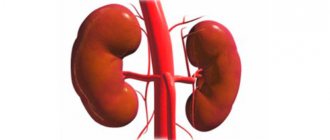Progesterone is a female hormone that is also produced in small quantities by the male body. A woman's body produces progesterone during periods of preparation for conception, pregnancy, and breastfeeding. Outside of these periods, elevated progesterone is a bad sign. Changes in hormonal levels are a symptom of diseases associated with many body systems. There are several reasons why progesterone increases abnormally. Even without tests, a woman can feel changes in characteristic symptoms.
What is progesterone responsible for in the female body? Hormone functions
Progesterone is an important and essential hormone that is produced by the adrenal glands as well as the ovaries. During pregnancy, the substance is additionally produced by the placenta.
Experts have found that the health and normal functioning of the reproductive function in the female body is directly related to the level of progesterone in the blood. It is he who is responsible for preparing the organs for long-term gestation, and also affects the endometrium, making it a favorable place for the attachment of a fertilized egg.
Additionally, progesterone is responsible for preparing the mammary glands for the lactation period. It is responsible for the production of eggs in the body of a non-pregnant woman and promotes fertilization.
In addition, the hormone performs other important functions:
- Prevents the formation of cysts and other pathological foci in the ovaries and uterus.
- Slightly reduces blood viscosity, which reduces the likelihood of blood clots.
- Regulates the level of glucose in a woman’s blood and prevents sudden jumps in indicators.
- Prevents contraction of the uterus during pregnancy, which significantly reduces the risk of miscarriage or premature birth.
- Slightly increases blood pressure.
- Stops menstruation after conception, which also reduces the likelihood of miscarriage.
All these functions are carried out in the body only with normal progesterone levels. If its level deviates in one direction or another, all processes in the body are disrupted.
Laboratory blood test
The hormonal level in a woman's blood is measured several times. This is necessary to track production dynamics and identify pathologies. High progesterone is monitored by:
- 7 days before the start of the menstrual cycle (if the results are in doubt, repeat tests are taken);
- 7 days after the end of menstruation;
- After another 14 days;
- The last analysis is taken after 20 days.
Based on the results of the study, a conclusion is drawn about the quantity of the hormone produced and whether this can be considered a pathology. If so, the doctor will prescribe examinations from other specialists.
How to prepare for diagnosis
Having noticed symptoms of increased progesterone, a woman needs to undergo several blood tests.
To make the results as reliable as possible, it is recommended:
- Take the test in the morning, on an empty stomach;
- Do not drink coffee, tea, alcohol, or spicy foods the day before blood sampling;
- Do not smoke 1 hour before the procedure.
The patient’s main goal is to take the test in the natural state of the central nervous system, without external stimuli in the form of food, alcohol, or nicotine.
Progesterone levels in women by age
Progesterone is elevated in women of different ages, which is associated with the individual characteristics of the body and associated abnormalities. But there are norms for each age group.
| Age group | Normal indicators |
| 16-20 years old | 0.15 – 24 ng/ml |
| 20-40 years | 0.10 – 28 ng/ml |
| 40-55 years | 0.34 – 0.92 ng/ml |
Progesterone may be elevated in women.
To check this, normal readings are important. It is worth noting that the amount of progesterone depends on the phase of the menstrual cycle.
The highest level is observed in the luteal phase. In addition, during pregnancy the level of the hormone increases several times.
Signs
The nature of the symptoms is individual for each woman, it depends on the concentration of progesterone in the blood and the general condition of the body. With hyperprogesteronemia, increased excitability, irritability, and depressive states are observed.
When 17-OH progesterone is elevated, symptoms may include:
- feeling of breast engorgement;
- the mammary glands become painful and sensitive on palpation;
- a woman's weight increases;
- intestinal problems;
- a previously non-troubling acne appears on the face;
- my legs begin to swell.
During this period, women quickly get tired, experience dizziness, and migraines appear more often. In addition, memory concentration decreases and anxiety appears. The possibility of panic attacks cannot be ruled out.
For hyperprogesteronemia, make an appointment with a gynecologist and endocrinologist. This disorder can cause numerous endocrine diseases, so you should carefully check the body.
Maintenance during pregnancy and after childbirth. How hormone levels change
The pregnancy period is considered especially important for a woman’s body, since changes occur not only in the reproductive organs. In the 1st trimester, progesterone levels increase and range from 8.9 to 400. Any indicator within these figures is considered normal. In some women, the level increases slightly, in others it borders on the upper permissible norm.
In the 2nd trimester, the numbers decrease slightly, and the upper limit no longer exceeds 303 ng/ml. However, the lower minimum is already 71 ng/ml. In the 3rd trimester, the numbers are the highest - from 88 to 770, which indicates the body is preparing for childbirth.
After the birth of a child, progesterone levels decrease slightly and remain within the levels characteristic of the 2nd trimester of pregnancy.
This is due to the need to regulate the lactation process. After a few months, the amount of the hormone decreases to levels characteristic of the 1st trimester of pregnancy. After cessation of lactation, normalization of hormone levels occurs within several weeks.
What are the dangers of elevated progesterone levels?
Progesterone is elevated in women for various reasons, but a significant deviation upward poses a health hazard. Most often, when the hormone increases in the blood, there is an unjustified increase in a woman’s body weight, even if she does not eat a lot of food and leads an active lifestyle.
This deviation is associated with improper distribution of fats in the body. This process is also regulated by progesterone, and deviation from the norm leads to disruption of metabolic processes. Moreover, even after normalization of indicators, returning to your previous body weight is not so easy.
In addition, an increase in the amount of an important hormone certainly leads to disruption of the intestines. If untreated, the disorder affects the uterus and nearby organs, and symptoms of inflammatory diseases appear.
Elevated levels of progesterone cause the greatest harm to women of reproductive age, as they lead to difficult-to-treat infertility.
How to reduce
Before starting therapy, the cause of the pathological condition should be established. This may require additional clinical studies of progesterone, testosterone, and other hormone levels. They also conduct special stress tests to identify congenital adrenocortical insufficiency, ultrasound diagnostics, computer and magnetic resonance imaging. Once the final diagnosis is made, a treatment plan is developed.
Decreased progesterone in PCOS and tumors
Infertility due to PCOS requires complex therapy. For this purpose, combined oral contraceptives (COCs) are prescribed, which correct the menstrual cycle and hydroxyprogesterone levels. If pregnancy does not occur after correction, other methods of therapy are used - stimulation of ovulation or surgical treatment with dissection of the sclerotic membrane of the ovaries.
Treatment tactics for hormone-producing cysts, ovarian tumors or adrenal tumors are usually surgical. The pathological focus is removed surgically. For corpus luteum cysts, in some cases, conservative therapy with COCs is possible. Only after this do they plan to become pregnant.
Decreased hormone levels due to adrenal dysfunction
Congenital adrenal dysfunction is treated with glucocorticoids. The medicine, dosage and duration of administration are selected by the doctor.
Dexamethasone or Methylprednisolone tablets are usually prescribed. The dose of the drug is divided into 2-3 doses per day. Therapy is carried out until 17 OH progesterone decreases, then the dosage of the drug is gradually reduced and pregnancy is planned.
During gestation, the pregnant woman is under the supervision of a doctor. The decision to continue therapy during pregnancy is made individually in each case. If the level of hydroxyprogesterone remains high and exceeds the norm by 2-3 times, hormonal therapy is again prescribed, especially when the female gender of the fetus is confirmed. In severe cases, the drug may need to be taken throughout life.
Treatment for Itsenko-Cushing syndrome
It can also be treated either conservatively (hormonal therapy) or surgically. For example, for pituitary tumors, it is possible to irradiate the affected area or remove the tumor.
Since hormonal drugs are used to reduce the level of 17 OP, treatment must be prescribed and monitored by a doctor. It is impossible to correct hormonal levels by other means, but they can be used as an additional factor.
Nutrition for high progesterone
Traditional medicine uses infusions of rowan flowers, cloves (flowers, buds), carrot seeds, hogweed stem and others. But you can take them only after consulting a doctor.
Proper dietary nutrition can also speed up treatment. A diet for such a pathology should include a minimum amount of protein products and be rich in vegetables and fruits. Dishes made from carrots, potatoes, beets, onions, and legumes (peas) are healthy. It is also necessary to saturate the body with vitamin C, which is abundant in citrus fruits, fresh herbs, sea buckthorn berries, and raspberries.
An increase in hydroxyprogesterone levels indicates hormonal disorders that are associated with various pathologies that require treatment and correction. It can cause infertility and miscarriage. Treatment is selected depending on the cause that caused the hormonal changes.
source
Reasons for increased progesterone
There are several predisposing factors that can provoke upward deviations in indicators. But some of them are more common.
Menstrual cycle and pregnancy
These reasons are the most common and are not considered a deviation, since the process is physiological and natural. In the luteal phase of the menstrual cycle, the indicators increase several times, which is not considered a pathology. Normally, after moving to another phase of the cycle, all numbers are normalized.
During pregnancy, exceeding the normal level is also considered a natural process associated with preparing the body for the upcoming pregnancy and childbirth. It is important at this time to regularly determine the indicators so as not to miss a pathological excess.
Adrenal cortex dysfunction
The main part of progesterone is produced by the adrenal glands, namely their cortex, so any violations can cause deviations. The most common cause of dysfunction is malignant neoplasms.
However, organ injuries, metabolic disorders and the use of potent drugs can also lead to increased levels. At the same time, the patient not only shows a change in indicators, she gains weight, and her mood sharply worsens. As the disease progresses, there is a decrease in sexual desire, depression, and intestinal disorders.
Neoplasms
Progesterone is elevated quite often due to the formation of tumors in the body. In most cases in women they are benign, but this does not exclude the possibility of a malignant neoplasm. As a rule, the tumor is located on one or two ovaries. It is difficult to detect it in the initial stages; there are no symptoms.
Only in 10% of cases the neoplasm is detected in a timely manner during diagnosis, but the patient usually consults a specialist with other complaints. In addition to general symptoms manifested in the form of weakness, menstrual irregularities, women have problems conceiving.
Hydatidiform mole
Pathology is a disorder in which, after the attachment of a fertilized egg, embryonic tissue grows into the uterus. On an ultrasound examination, you can see many small bubbles that have settled in the uterus. Pregnancy in this case no longer develops, but the likelihood of the vesicles developing into a malignant tumor increases significantly.
The level of progesterone in this case corresponds to the expected pregnancy period or slightly exceeds it. The woman feels weakness, pain in the lower abdomen, and brown or dark red discharge with an unpleasant odor appears.
Hormone concentration analysis
This analysis is prescribed for:
- disruption of the menstrual cycle;
- problems with conception (if there is no pregnancy for a year without using contraception);
- dysfunctional uterine bleeding;
- a history of several pregnancies that ended in miscarriages with symptoms that indicate progesterone deficiency;
- before IVF.
Since the level of the hormone is not constant, the day of the menstrual cycle is important for taking the test. As a rule, a woman is recommended to donate blood in the luteal phase, on the 22-23rd day of the cycle. Data obtained during this period are the most reliable and informative.
A few days before the test, you must stop smoking, drink strong tea and coffee, and alcoholic beverages. It is also not advisable to take any medications that may interfere with the reliability of the results. If it is impossible to stop taking the medication, you need to notify your doctor.
For pregnant women, a test for the amount of progesterone is often prescribed in the second half of pregnancy in order to determine the condition of the placenta. High levels of the hormone will be noted during post-term pregnancy, when “aging” of the placenta occurs.
The test is prescribed in the morning; blood must be taken on an empty stomach. At least eight hours should pass after the last meal. Drinking water is allowed. The results will be ready the next day.
Symptoms of excess progesterone
If there is a slight upward deviation in the indicators, the patient does not feel any serious changes, and attributes the signs that appear to overwork.
But as the hormone level increases, pronounced symptoms appear:
- Apathy and indifference to all activities, inability to concentrate on any task.
- Weakness, which manifests itself not only when performing physical work, but also at rest.
- The appearance of small rashes or large acne on the skin of the face, chest and upper back.
- Severe headaches, even migraines, which often bother the patient at different times of the day.
- Chest pain, breast engorgement.
- Decreased sexual desire, up to its complete absence.
- Increased work of the sweat glands even in the absence of intense physical activity.
- Disorders of the stomach and intestines, flatulence.
- Deterioration of appetite or pathological cravings for food.
- Constipation accompanied by spasms of intestinal smooth muscles.
In each case, certain symptoms may be absent, so the doctor makes a diagnosis based on existing signs.
Symptoms of the pathological condition
The following signs indicate that progesterone is higher than normal:
- low blood pressure;
- disruptions in the menstrual cycle, frequent delays, followed by heavy painful bleeding;
- the appearance of acne on the face, shoulders and back in adulthood;
- hardening of the mammary glands, pain and discomfort when pressing;
- weight gain;
- deterioration of hair and nails;
- disturbances in the gastrointestinal tract: increased gas formation, constipation, bloating, heartburn;
- swelling of the lower extremities;
- chronic fatigue without increasing physical and intellectual stress;
- depressive state, predominance of depressed mood, apathy, irritability and moodiness.
Diagnostics
To diagnose the condition, specialists use a standard examination. The first stage will be a simple survey of the patient and a general examination of the skin and mucous membranes. It is important to determine the first manifestations, their intensity, as well as the presence of abnormalities in other organs.
After this, a clinical and biochemical blood test is prescribed. The first helps to assess the general condition of the body, the second – the functioning of the digestive and cardiovascular systems. After this, an analysis is prescribed for the hormones of the thyroid gland and adrenal cortex.
Not only the level of progesterone is taken into account, but also the indicators of other hormones that are responsible for the health of the reproductive system.
After accurately determining the level of progesterone, specialists usually prescribe additional examination. Ultrasound diagnostics is considered the most informative method, which allows you to detect even minor deviations from the appendages and uterus. The doctor may see tumors, areas of endometriosis, ovarian cysts, and other abnormalities.
If the previous methods are insufficiently informative, magnetic resonance imaging is used. All internal organs are examined, which makes it possible to detect even minor pathological changes. After receiving the diagnostic results, the final diagnosis is established.
Treatment and its features
Significant hyperprogesteronemia in non-pregnant women requires medical adjustment.
If a woman’s progesterone is higher than normal, the gynecologist individually, based on test results, selects a treatment regimen.
Initially, it all depends on how the elevated hormone manifests itself and what complications there are. If the cause is an existing disease, then the main efforts should be directed towards its treatment.
The following methods are used to reduce progesterone levels:
- drug therapy;
- surgical intervention;
- diet;
- physiotherapy.
Drugs that can lower the hormone belong to a variety of pharmacological groups. The most commonly used pills are oral contraceptives , which contain a specific combination of hormones. They suppress the action of progesterone and lower its level.
Contraceptives Yarina, Zhanin, Diane-35, Anteovin can be used as a treatment for hyperprogesteronemia. Synthetic analogues of the hormone estriol, which are no less effective in correcting the hormone, have also proven themselves well.
Epostan (progesterone inhibitor) significantly eliminates the manifestations of hyperprogesteronemia. Therefore, it is often prescribed by doctors to correct hormonal levels. In some cases, gynecologists prescribe medications such as Mifepristone, Tamoxifen, Clomiphene , etc.
All of these drugs should not be taken during pregnancy because they can cause spontaneous abortion and intrauterine complications.
Usually a woman has to treat the underlying disease that caused the increase in progesterone.
If an ovarian corpus luteum cyst has been detected, the basis of treatment will be routine diagnostic observation or anti-inflammatory therapy.
In many clinical cases, oral contraceptives are also used , which are prescribed by a doctor. In severe stages of the disease, surgical removal of the cyst or resection of the ovary is performed if there are additional pathologies.
Malignant tumors that intensely produce the hormone must be surgically removed along with the ovary. The woman is then treated with anticancer drugs and chemotherapy.
If the pathology is caused by nephrotic diseases (adrenal dysfunction, renal failure), then special medications are used that restore the function of the kidneys and adrenal glands. For adrenal pathology, corticosteroid hormones are prescribed , the dosage of which is prescribed by the doctor.
For kidney diseases, the doctor prescribes anti-inflammatory therapy. In any case, the doctor first diagnoses the patient, prescribes additional examinations and tests, and then individually selects a treatment regimen.
Medicines to lower progesterone levels
Progesterone is elevated in women not only during pregnancy, so conservative therapy can be used as a method of normalizing levels in non-pregnant patients.
The most popular and effective means are the following:
- Mifepristone – a medicinal product that has an effect due to the content of the active component of the same name. It is most often used for medical termination of pregnancy, as it sharply reduces progesterone levels and provokes miscarriage. Usually the course lasts no more than 5 days. The tablets are used under medical supervision. The dosage is determined strictly individually. The product has many contraindications, therefore it is available with a prescription and is prohibited for independent use.
- Clomiphene is a drug based on the active substance of the same name, prescribed only to non-pregnant women and in short courses of 5-7 days. Typically, the patient takes no more than 2 tablets per day with a dosage of 50 mg each. The drug reduces estrogen levels, stimulates ovulation, and prevents infertility. An absolute contraindication for use is acute and severe liver damage.
- Tamoxifen is an effective medication in tablet form that quickly reduces progesterone levels and prevents the formation of hormone-dependent tumors. The dosage in each case is determined individually, the course lasts from 7 to 20 days, depending on the degree of neglect of the condition.
- Afobazole is a sedative drug that is often prescribed in combination with hormonal drugs. Helps eliminate anxiety and restlessness, normalizes sleep, and prevents the development of depression. The patient is prescribed 1 to 2 tablets per day; it is better to take them before bed for 10 days. It is worth noting that the medication is not prescribed if there is intolerance to its components, or during pregnancy.
- Tempalgin is an anesthetic drug used for severe headaches. Many patients suffer from a similar symptom, which worsens the quality of life. It is necessary to take 1 tablet only when discomfort occurs. The product is not used during pregnancy, or if you are allergic to its components.
Any of the drugs is considered potent and very dangerous if the rules of use are violated. That is why experts insist on preliminary consultation.
Proper nutrition and lifestyle
The most gentle and accessible method of correcting hormonal levels is proper nutrition. We can speak about the effectiveness of a diet only when it is supported by regular use of prescribed medications.
Recommended products and dishes:
- low-fat fermented milk products (kefir, fermented baked milk, natural yogurt without additives, low-fat cottage cheese);
- lean meat (veal, turkey);
- seasonal vegetables and fruits;
- oatmeal, buckwheat, millet porridge;
- low-fat sea fish;
- greens (parsley, dill, basil, oregano);
- flaxseed, olive or sesame oil;
- green tea or mint tea, natural juices, fruit drinks.
Low fat content in the foods consumed is the main key to the success of the diet. The fact is that progesterone is perfectly broken down in fats. By consuming foods with high levels of fat, a person will help increase the level of the hormone.
Fatty, spicy and smoked products should be excluded from the menu, including butter, fatty cheeses, meat and fish pastes, pastries, sweets, and various confectionery products with creams. You should minimize the consumption of foods such as nuts, sunflower and pumpkin seeds, and legumes (peas, lentils, chickpeas). Strong teas, coffee, and fast food products are excluded from the diet.
If you have a hormonal imbalance, you should never self-medicate or self-diagnose. All hormonal drugs, even the new generation, have a number of contraindications and, if taken uncontrolled, can cause serious consequences for the body, for example, the formation of blood clots. Only a doctor has the right to prescribe medications and determine their dosage and duration of treatment. Incorrect use of hormonal drugs during pregnancy is especially dangerous.
If pain, bleeding, or menstrual irregularities occur, you should immediately seek medical help. You should limit physical activity if you have ovarian cysts or other benign formations of the genital organs. Before planning a pregnancy, it is advisable to undergo a full medical examination to identify possible pathologies, including those in the hormonal system.
Elevated progesterone levels bring a lot of inconvenience to a woman’s life. But this pathology is not a death sentence. Observation by an experienced doctor and compliance with all recommendations in combination with a proper diet and a healthy lifestyle will normalize hormonal balance, eliminate unpleasant symptoms of the disease and make a woman’s dream of becoming a happy mother come true.
source
Diet
Diet is an additional treatment method. Some foods can slightly reduce progesterone levels and improve the functioning of the digestive system. In most cases, a pathological increase in the hormone is accompanied by an increase in body weight, so it is worth eating more vegetables and fresh fruits.
It is recommended to give up carbonated drinks and replace them with natural juices and compotes. In addition, it is recommended to limit the amount of protein foods in the daily diet. Fatty meat and lard should be consumed in minimal doses. Full-fat dairy products are also considered not the best choice for an obese woman.
To ensure a healthy diet, it is recommended to avoid salty and smoked foods, as well as canned foods. Portions should be small, meals should be frequent. It is important not to force the body to experience severe hunger, since in this case all the calories received will be stored as fat.
It is additionally important to ensure a normal drinking regime and consume 30 ml of liquid for every kilogram of weight. This will allow toxins and harmful substances to be quickly eliminated from the body, and intestinal function will improve significantly. In any case, an experienced nutritionist will help you create the right diet after examination and studying test results.
Pregnant women also often need to follow a diet, but they should not give up certain foods on their own. When drawing up a menu for a patient, the specialist takes into account the duration of pregnancy, the individual characteristics of the body, and the degree of deviation in progesterone levels.
Nutrition during therapy
Proper nutrition plays a particularly important role in the treatment process. A properly selected menu will help restore hormonal levels. Foods containing protein that can increase progesterone. Protein is found in:
Eating such foods will not immediately increase your progesterone levels, but it is still not advisable to include these ingredients in your diet as they affect its production.
Traditional treatment
Progesterone is elevated in women of different ages and for various reasons, so many trust alternative medicine recipes, considering them a safe alternative to hormonal therapy. However, it is worth remembering that such remedies cannot replace traditional treatment, but act only as an auxiliary method that alleviates a woman’s condition.
Decoction of red rowan berries
A simple folk remedy has positive properties, normalizes hormonal levels and improves the functioning of the adrenal cortex, which is important when correcting progesterone levels.
Preparing the medicine is simple:
- Separate 20 g of fresh berries.
- Grind, but do not make a paste out of the raw materials.
- Add 400 ml boiling water.
- Cook for 3 minutes.
- Leave to infuse for 1 hour.
- Filter the composition.
Take 100 ml of the finished medicine in the morning and evening. The duration of the course ranges from 10-20 days, depending on the degree of neglect of the condition. The drug is contraindicated in patients with high acidity of gastric juice, gastric and duodenal ulcers. Patients with kidney failure should not take the decoction.
Clove infusion
A product based on dried cloves helps cope with the external manifestations of the disease, stimulates skin restoration and prevents the appearance of rashes. With long-term use, even large acne can be eliminated.
For 350 ml of boiling water you will need 5 g of pre-crushed raw materials. After this, it is necessary to infuse the composition for at least 30 minutes. The filtered infusion should be divided into 4 equal portions and taken throughout the day. Continue treatment for at least 2 weeks in a row. After a 10-day break, the course can be repeated.
For patients with unstable blood pressure and a tendency to allergic manifestations, it is better not to take the infusion. It is not used during pregnancy and breastfeeding. If complications occur, you should immediately stop treatment and consult a specialist.
Infusion of wild carrot seeds
Wild carrot seeds have unique therapeutic properties. They not only normalize hormonal levels and prevent the formation of tumors, but also eliminate nervous tension. For patients with signs of depression, the remedy will be the best assistant in the fight against depression and apathy.
Preparing the infusion is simple: you need to take 10 g of seeds, add 700 ml of boiling water. It is better to infuse the product in a dark place for 24 hours. After this, the composition is filtered 2 times using gauze. The finished medicine must be taken 100 ml 3 times a day. The duration of the course is individual in each case, but the standard regimen involves using the infusion for 2 weeks.
Ways to stabilize hormonal levels
This deviation needs to be treated only if its pathological nature is revealed. First of all, it is necessary to exclude the presence of pregnancy, as the main factor of high progesterone. During this period, treatment is not required, and the woman should be under the constant supervision of specialists.
Medications
Medication is prescribed to restore normal progesterone levels in the event of pathological processes in the body. Before reducing hormone levels with specific drugs, it is necessary to eliminate concomitant diseases.
Medicines for hyperprogesteronomia:
- Clomiphene is a non-steroidal anti-estrogen that helps establish a relationship with estrogen receptors of the ovaries and pituitary gland.
- Tamoxifen – prevents the synthesis of female sex hormones and has an antitumor effect. Recommended for use in the presence of tumors in the breasts and genitals.
- Mifepristone is a synthetic antigestagenic agent that blocks progesterone receptors. It is most often used for medical abortion in early pregnancy.
To normalize progesterone levels, your doctor may prescribe oral contraceptives. More often these are products containing a combination of hormones:
- Yarina,
- Diana-35,
- Janine.
How and how to treat gynecomastia in men?
View a selection of effective treatment options. Chronic thyroiditis of the thyroid gland: what is it and how to treat the disease? Read the answer at this address.On the page https://fr-dc.ru/hormones/tireotropin/ponizhen-u-zhenshhin.html, learn about the symptoms of low TSH hormone in women and methods for stabilizing hormonal levels.
Diet and nutritional habits
This is the most gentle method of reducing progesterone. But with acute manifestations of pathology and with advanced hyperprogesteronomia, a diet to restore hormone levels is not enough.
Progesterone is highly soluble in fat. You should limit fatty foods and protein foods in your diet:
- nuts,
- meat,
- fatty dairy products,
- sunflower seeds, pumpkin seeds,
- legumes
The diet may include small amounts of lean meat and low-fat dairy products. It is useful to eat vegetables and fruits.
Traditional medicine
Proven recipes:
- Pour boiling water (1 cup) over rowan flowers or fruits (1 spoon). Take before meals for 2 weeks.
- Brew 1 spoon of carrot seeds in 200 ml of water. Drink 100 ml three times a day. The product helps normalize blood pressure and improve sleep quality.
- Prepare a decoction of red brush leaves (1 spoon per glass of water). Drink half a glass twice a day.
Consequences of increased progesterone in women
Without treatment, changes occur in a woman’s body. The risk of the formation of malignant tumors in the uterus and appendages, as well as other organs, increases significantly. One of the dangerous consequences is adrenal cancer.
If elevated levels of the hormone persist for a long time, liver failure and cirrhosis develop. Somewhat later, kidney symptoms appear and their function is impaired. In addition, women with such disorders almost always develop infertility, which is quite difficult and takes a long time to treat.
One of the less dangerous consequences is the formation of a benign tumor, but one should not exclude the possibility of its degeneration into a malignant one.
Progesterone can be increased under the influence of various factors. In women, this disorder most often occurs suddenly. To normalize indicators, specialists use conservative treatment, supplementing it with folk remedies and a proper diet.
Article design: Oleg Lozinsky
Consequences
High concentrations of the hormone can cause unpredictable consequences. There is a possibility of asynchronous development of the endometrium, as well as the subsequently formed embryo. If the increase in progesterone is caused specifically with the help of hormonal drugs, the effectiveness of implantation of the fertilized egg into the uterine wall may be impaired. At a concentration of 4 nmol/l or more in the follicular phase, a woman will not be able to become pregnant at all. It is also necessary to take into account that progesterone is a secretory product and affects the growth of follicles inside the ovary. The more follicles, the more hormone circulates in the blood.
If a woman has increased progesterone, the follicular phase is disrupted. It is not for nothing that this hormone should reach high levels after ovulation. If the test results are poor, it is recommended to seek help from a specialist - a gynecologist-endocrinologist, undergo further examination and begin treatment. To reduce hormone levels, various hormonal drugs are used (Mifepristone, Clomiphene, Tamoxifen and others). The dosage of medications is calculated individually. A diet that excludes fatty foods also helps eliminate hormonal imbalances. Some women need to undergo treatment for kidney and ovarian diseases to reduce hormone levels.
What role does progesterone play during menopause? Indications for the use of estrogen drugs. Treatment with traditional medicineCharacteristics of female hormones and their typesIndications for the treatment of menopause with new generation hormonal drugs











